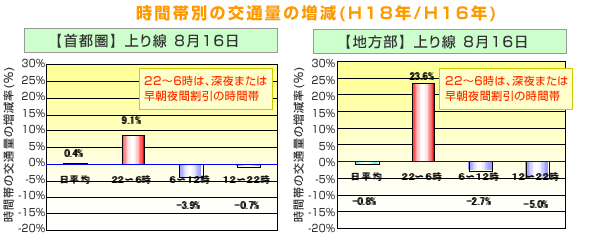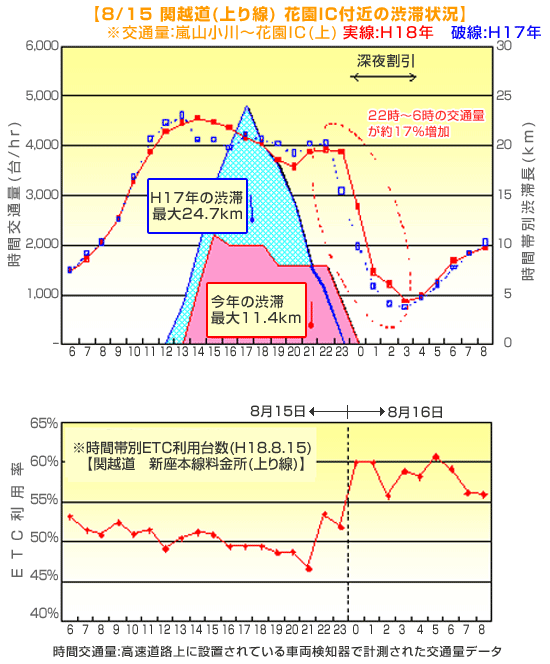Congestion alleviation effect associated with the use of the ETC time zone discount system
- Corporate Top
- Press Room
- Press Release Headquarters
- Congestion alleviation effect associated with the use of the ETC time zone discount system
September 8, 2006
East Nippon Expressway Co., Ltd.
Congestion alleviation effect associated with the use of the ETC time zone discount system
- Tohoku Expressway In-bound and Kan-Etsu Expressway In-bound, such as, the traffic volume is ETC time zone discount of at night (22:00 - next day 6) *1 It increased compared to the same period in 2004 before the introduction. This time is a time zone where "late night discount" and "early morning and night discount", which are limited to ETC, are applied, and the rate of increase in traffic volume is higher than other time zones. It seems that the use of was promoted.
(ETC usage rate in the NEXCO EAST area during the period is approximately 52%, 1.4 times the same period of the previous year) - Kan-Etsu Expressway In-bound in some sections of the, day traffic despite almost the same as the synchronization previous year, the traffic volume of the time zone in which congestion occurs during the day is reduced, traffic volume increases over the morning from midnight There was a change in traffic in some time zones, and there was a day when traffic congestion decreased.
The traffic volume before and after the "ETC Midnight Discount" time zone (0-4pm) has increased significantly compared to the same period of the previous year, and with the improvement of the ETC usage rate, promotion of midnight usage, where discounts are applied, is planned. It may have contributed to alleviating traffic congestion.
- 1 Midnight discount, early morning night discount, commuting discount
1 Changes in hourly traffic volume during the Bon Festival
- Tohoku Expressway, Joban Expressway, Kan-Etsu Expressway of In-bound in the line, traffic of late night, early morning (22:00 - the next 6) has been increased significantly compared to the synchronous 2004. Also, compared to the changes in traffic volume during other time periods, this time period increased significantly.
This tendency was found in both the metropolitan area and rural areas.

Target section:
〔Capital Area〕
Tohoku Expressway Urawa TB-Iwatsuki IC (upper and lower)
Joban Expressway Misato JCT-Nagareyama IC (upper and lower)
Kan-Etsu Expressway Oizumi JCT-Tokorozawa IC (upper and lower)
[Rural area]
Tohoku Expressway Murata JCT-Sendai Minami IC (upper and lower)
Joban Expressway Iwaki Yumoto IC-Iwaki JCT (up and down)
Kan-Etsu Expressway Nagaoka IC-Nagaoka JCT (up and down)
Target period:
Peak day of traffic volume for In-bound (comparison with 2004 before introduction of ETC time zone discount)
H16) Monday, August 16
H18) Wednesday, August 16
2 Tuesday, August 15 Kan-Etsu Expressway In-bound Garden IC-Case of Takasaki JCT
(Traffic in the vicinity of Honjo Kodama IC)
- The daily traffic volume increased by about 3% compared to the same day of the previous year, but the amount of traffic congestion *1 Was reduced by about 40%.
Traffic congestion H17 year: 134.5km・hr ⇒ H18 year: 78.8km・hr (▲41%) - Due to the improvement of ETC usage rate, the traffic volume during the daytime congestion decreased from 2005, and the traffic volume increased from midnight to morning.
Daily traffic (8/15 6:00-8/16 6:00) H17: 70.7 thousand ⇒ H18: 72.5 thousand (+2.5%)
Late night/early morning traffic volume (22:00-6:00) H17: 13.9 thousand units ⇒ H18 year: 16.3 thousand units (+17.3%)
Traffic volume during times other than midnight and early morning H17: 56.7 thousand ⇒ H18: 56.2 thousand (-0.9%)
- 1 "Traffic volume" is an index that indicates the size of traffic (congestion length x congestion time)

